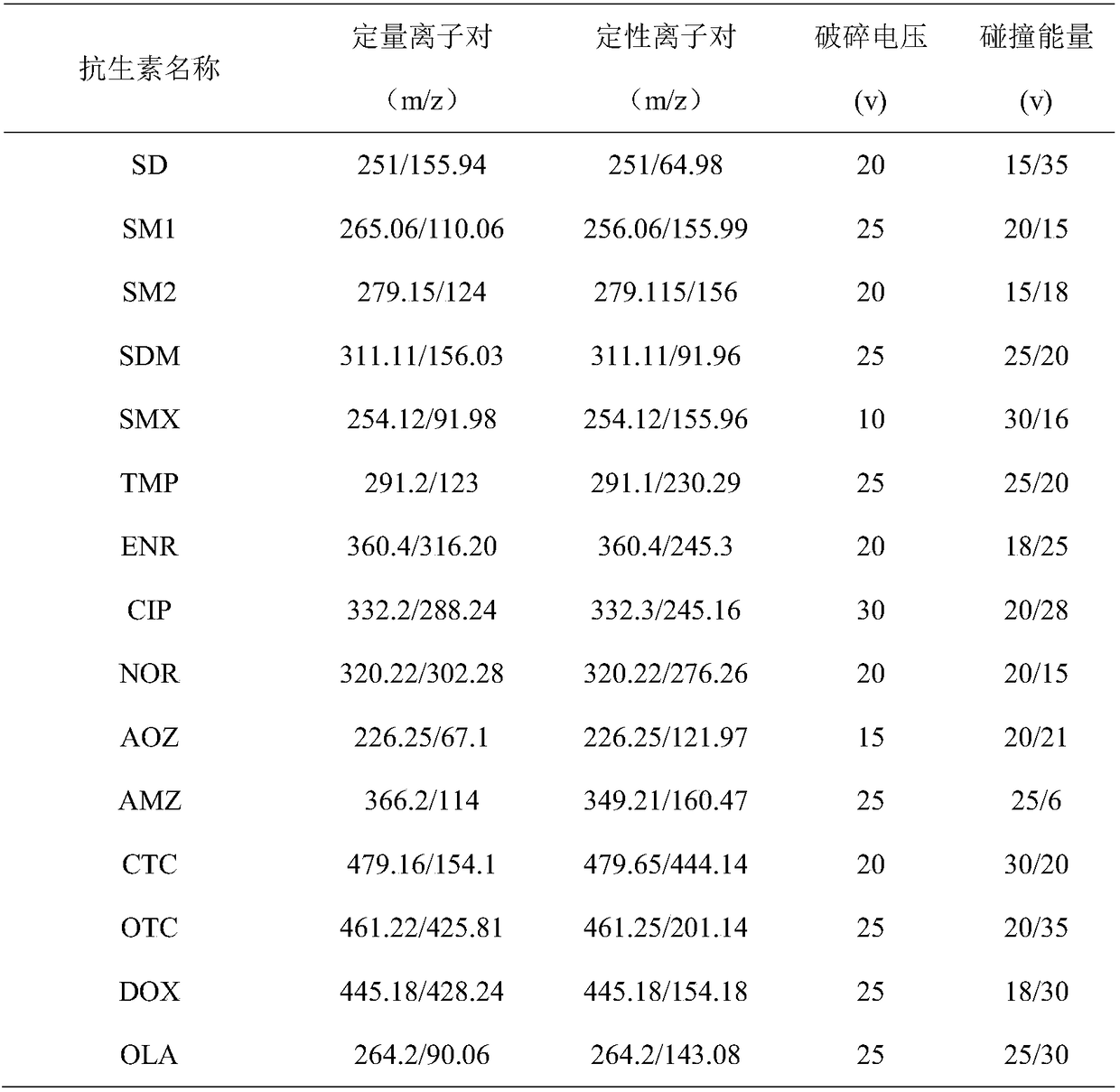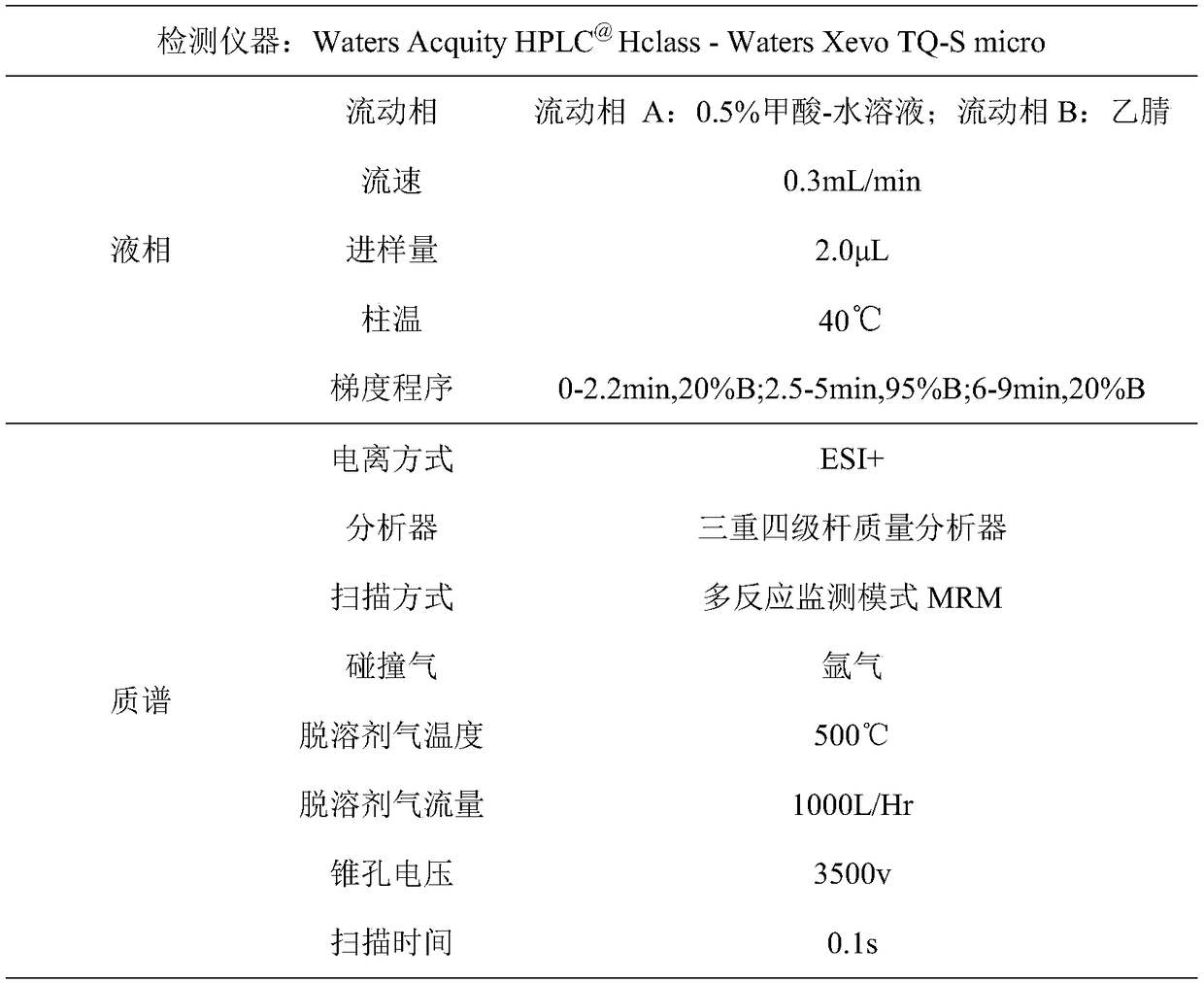Method for simultaneously detecting 15 antibiotics in aquaculture sediment by combining microwave extraction-solid phase extraction pretreatment with liquid chromatography-mass spectrometry technology
A technology of aquaculture and liquid mass spectrometry, which is applied in the field of organic pollutant residue detection, can solve the problems of limited types and quantities of antibiotics, unstable detection methods, limited recovery rate, etc., achieve stable detection results, reduce the amount of extractant, The effect of high recovery rate
- Summary
- Abstract
- Description
- Claims
- Application Information
AI Technical Summary
Problems solved by technology
Method used
Image
Examples
Embodiment 1
[0044] Embodiment 1: the pretreatment of sample
[0045] There are many kinds of target antibiotics, and their physicochemical properties vary greatly. In order to maximize the extraction efficiency of various antibiotics in the sediment, the present invention uses a single factor test to study the extraction effects of five different extracts on the target substances.
[0046] Specifically follow the steps below:
[0047] After the collected bottom mud was freeze-dried, it was ground and passed through a sieve with a pore size of 0.25 mm. Set up two sets of sediment samples for comparative tests, one set is the standard sample set, the other set is the blank sample set, and each set has two parallels. Accurately weigh 2.00 g of sediment samples into 100 mL beakers. Add respectively low, medium and high antibiotic mixed standard solutions (i.e. the mixed standard solution of 15 kinds of antibiotics) of three concentrations in the standard sample group, promptly add the antib...
Embodiment 2
[0053] Embodiment 2: the establishment of detection method
[0054] (1) Optimization of mass spectrometry conditions
[0055] Liquid chromatography-tandem mass spectrometry enables accurate quantitation using characteristic fragment ions. Therefore, it is necessary to optimize the fragmentation voltage and collision energy to obtain the best molecular ion-fragment ion pairs, so as to make the subsequent detection and analysis of actual water samples more accurate.
[0056] Using the direct injection method, each solution sample containing 100 μg / L target antibiotic was injected into the ion source respectively, and the parent ion full scan was performed in the positive ion detection mode to obtain the parent ion with the maximum response value of each antibiotic, and then carried out Secondary mass spectrometry scans to obtain qualitative ions and quantitative ions. The mass spectrometric analysis parameters of 15 antibiotics in multiple reaction mode (MRM) are listed in Tab...
Embodiment 3
[0081] Embodiment 3: the mensuration of actual sample
[0082] Collect the bottom mud of fish ponds, shrimp ponds, and crab ponds in an aquaculture area in Shanghai, first use the pretreatment method of the present invention to extract, enrich and purify the samples, and then use the detection method of the present invention to detect and analyze the actual concentration of the samples , to examine the applicability of this method to different types of sediment samples.
[0083] Specifically follow the steps below:
[0084] (1) Extraction of antibiotics: microwave extraction
[0085] After the collected bottom mud was freeze-dried, it was ground and passed through a sieve with a pore size of 0.25 mm. Add 100ng of sulfamethoxazole- 13 C 6 , Norfloxacin-D 5 , Penicillin G Potassium Salt-D 5 , Tetracycline-D 6 , olaquindox-D 4 , Amoxicillin- 13 C 6 and trimethoprim-D 3 The seven internal standards indicating the recovery rate were thoroughly mixed with the sediment sam...
PUM
| Property | Measurement | Unit |
|---|---|---|
| pore size | aaaaa | aaaaa |
Abstract
Description
Claims
Application Information
 Login to View More
Login to View More - R&D
- Intellectual Property
- Life Sciences
- Materials
- Tech Scout
- Unparalleled Data Quality
- Higher Quality Content
- 60% Fewer Hallucinations
Browse by: Latest US Patents, China's latest patents, Technical Efficacy Thesaurus, Application Domain, Technology Topic, Popular Technical Reports.
© 2025 PatSnap. All rights reserved.Legal|Privacy policy|Modern Slavery Act Transparency Statement|Sitemap|About US| Contact US: help@patsnap.com



